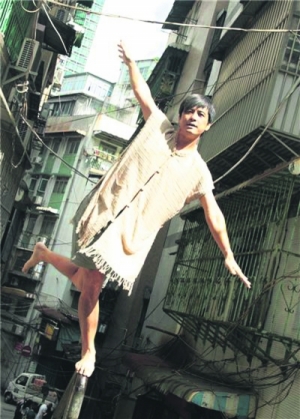 |
Truth’s a Dog Must to Kennel, a smart intellectual solo theatre performance of Tim Crouch, criticises the popular British theatre through an imagined scenario in which The Fool deserts his role in Shakespeare’s King Lear. Tim serves as both the playwright and the performer for the theatrical work under the co-direction of Karl James and Andy Smith. The work first premiered at the Edinburgh Fringe Festival in 2022 when the theatre industry was still recovering from the COVID-19 pandemic. The author attended the performance staged in the Studio Theatre, Hong Kong Cultural Centre (“the Studio”), a programme for the 52nd Hong Kong Arts Festival.
This atypical performance proves to be challenging for the audience, particularly the Hong Kong audience, in a couple of ways. On one hand, the audience was assumed to be familiar with King Lear, the Shakespearean classic. Memories of certain scenes of the play were triggered instead of displayed on stage. There was neither an introduction of its characters’ relationship nor a summary of its plot. Without the exposition, audiences who possessed no knowledge of this essential information would struggle to interpret the meaning of the work. On the other hand, the audience must endure the spectacle-less aesthetic. To put it bluntly, for 70 minutes, all the audience members observed was a black-clothed performer uttering words and gesturing on a bare stage accompanied by subtle ambient sound designed by Pippa Murphy and transparent light designed by Laura Hawkins. Omitting the mic stand and the water bottle sitting on top of a stool at the upper-stage-left corner, the tape marks on stage right conveyed a deserted stage, matching the wasteland imagery often associated with King Lear. Without a spectacle on stage, the audience must rely on Tim’s beautiful incantation-like words and harness their imaginations to create the scenes in their minds. For some audiences, there was a huge gap between the actual performance and their expectations. These barriers might have prevented the audience from comprehending Tim’s creative intentions properly.
(©Stuart Armitt, provided by Hong Kong Arts Festival)
The non-sequential and convoluted plot consisting of three narrative threads confused the audience further, and worse still, Tim continuously switched from one narrative thread to the other. The three threads are organised and elaborated in detail below.
The first thread was an excerpt of three scenes in King Lear from the point of view of The Fool. The most important one was an altered scene of The Fool leaving his role during the thunderstorm with King Lear because he “can't do this anymore”. This creative alteration was the premise of the performance. The others were unaltered scenes of Gloucester’s eyes being gouged out, and Gloucester deciding to jump off an imaginary cliff. These scenes were outlined by Tim’s vivid descriptions and gestures, and were then filled in by the audience’s memories and imaginations. The audience could to a degree understand intellectually why The Fool chose to leave but they were unable to empathise with The Fool. In this thread, the audience’s memory was recalled to enable intertextual reading of the other two threads.
The second thread was situated in a British theatre with balconies ("the Theatre") showing King Lear at an unspecified time in the recent past. The scenario was constructed by Tim pointing at various audience seats in the Studio, giving brief remarks to the seat incumbent and identifying the ticket price for the seat. The use of British pound currency and a couple of irregularities, such as the absence of ushers, indicated that Tim was addressing the spectators in the Theatre instead of the audience in the Studio. Tim continued to describe the spectators’ behaviour at multiple moments of the show, and to sprinkle his criticisms of the theatre’s lifelessness. The key actions in this thread were: The actor of The Fool quitted; a lady immensely disturbed by the gouging out Gloucester’s eyes was escorted out; and a pre-dinner male audience suffering a heart attack mid-show was aided out and died. Without a clear focus in this thread, these events left the audience wondering about their significance to the entire performance.
The third thread resembling a stand-up comedy was the most entertaining of them all. In this thread, Tim took off his fake VR headset, looked into the audience’s eyes and presented assorted jokes including a self-deprived joke and multiple genie jokes. These were instances when genuine communications between Tim and the audience were established. The best-received joke was about King Lear’s extended family exhibiting a distilled version of their violent and obscene conflict at a national talent competition. The frequent use of “you-know” to censor inappropriate content in Tim’s rapid narration evoked contradictory feelings of amused and disturbed at the same time. In contrast to the convoluted first and second threads, the directness of the third thread facilitated immediate comprehension of the audience.
As a whole, the three distinct threads were pieces of a puzzle for the audience to solve and to deduce the meaning. The three threads were connected by a single action: Someone left because he “can't do this anymore”. The Fool in the first thread deserted his character role for the second thread, and then, the actor of The Fool quitted his performer role for the third thread. The unity of action was obeyed, yet the motive of the action was unclear due to its ambiguous agent.
Tim had a composite presence in the performance. Tim was The Fool, the character in King Lear; he was also the actor of The Fool in the Theatre; and he is Tim Crouch, the artist, the writer and the performer of Truth’s a Dog Must to Kennel. Despite his multiple roles, Tim consistently exhibited The Fool’s defining traits—seeking jokes and revealing truths. For example, as a character, he conveyed the incidents of King Lear faithfully; as an actor, he stated the facts of the spectators; and as an artist, he told his jokes in front of a live audience. The point of focus was Tim Crouch himself. It was not why the character deserted. It was also not why the actor quitted. The question should be what statement Tim was trying to make by writing them to leave.
“No more jokes” is the hint. Tim no longer finds something enjoyable. What is it? Could it be things related to the theatre? Let’s verify this proposition in the three threads. In the first thread, Tim disapproved of the blood and violence being put on display on stage. As a counterargument, Tim demonstrated the image of blood and violence could be invoked in the audience’s mind with the ambiguous word “you-know”. In the second thread, Tim condemned the Theatre as outdated and it had become unrelated to the actual world. The disturbed woman, who viewed the gouging out of Gloucester's eyes as real, was considered by the Theatre as crazy and a disturbance; the spectators sympathised with the suffering on stage more than the agony of the pre-dinner man. To Tim, this is the real tragedy.
(©Stuart Armitt, provided by Hong Kong Arts Festival)
Tim reinforced his point with the use of the fake VR headset satirizing the existence of the fourth wall. The Theatre was living in its own virtual reality disconnected from the real world. Without the flattering decorations as a spectacle, the Theatre was unengaging and was communicating with restrictions. This explained why Tim always took off his VR headset in the third thread. He wanted to communicate directly with the audience without any barriers in the real world. And yes, this type of theatre was engaging, and the audience loved it.
Via the performance, Tim was proposing his ideal theatre where there was no separation between the stage and the real world, and where words and gestures empowered the audience’s imagination. It was a lovely picture and Truth’s succeeded in multiple instances to show glimpses of what his ideal theatre could be.
Diving deeply into the subject of theatre is not for everyone. Some audiences could not understand Tim’s act. Others didn't bother. Some may be offended. Others might be unconvinced. Yet, a few could be enlightened. Indeed, truth is a tough pill to swallow. That was why The Fool employed jokes as his instrument to reveal the harsh truth to his King.
Still, in the Shakespearean text, King Lear even threatened to whip The Fool before he said the line “Truth’s a dog must to kennel”. This line is also the title of Tim’s performance. Perhaps, this is exactly Tim’s genius scheme all along. To place the audience in the shoes of King Lear in the scenario when unpalatable truth was delivered by The Fool. Ultimately, it was King Lear who possessed the capacity to avoid the impending disaster. There is still time because Tim, our loyal fool, has not yet left us. We, the audience, must decide.
本網站內一切內容之版權均屬國際演藝評論家協會(香港分會)及原作者所有,未經本會及/或原作者書面同意,不得轉載。











